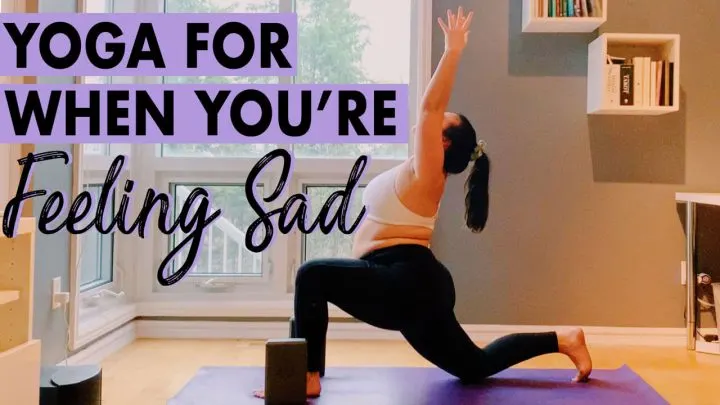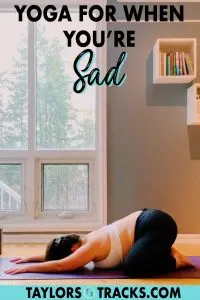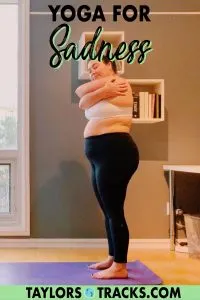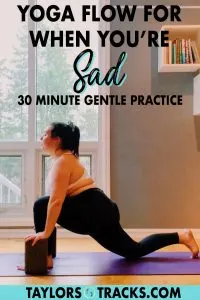Sadness is a strong emotion that can feel heavy and disruptive to your typical schedule or day. It’s typically not a welcome emotion but it’s a necessary one. Yoga is a great way to help you move through emotions, not ignore them, to notice them, and allow them to become unstuck from your body as quite often as humans we store emotions in our bodies.
So the next time you’re feeling sad, instead of pushing it away and doing your very best to act okay, try one of these yoga poses or the yoga for sadness flow below to help you become present and be perfectly okay with where you’re at emotionally.
Top 5 Yoga Poses for Sadness
Try adding these yoga poses into your next routine to help support your emotional health through whatever it is you’re experiencing.
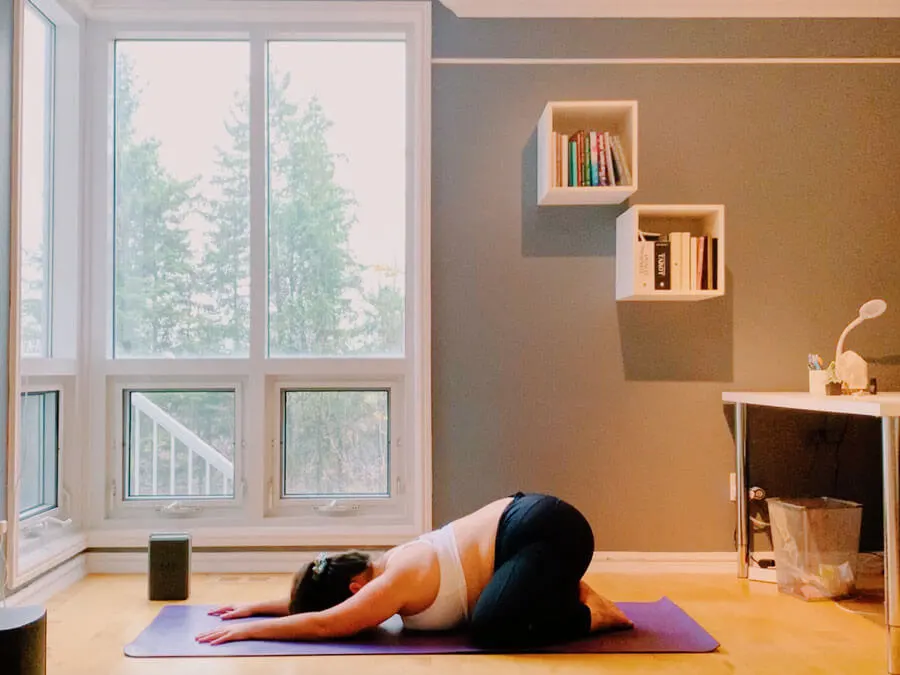
Child’s Pose (Balasana)
One of the most comforting poses in yoga, child’s pose is a great way to feel grounded and supported, which is a great feeling when you’re sad.
Begin by coming to your knees, sitting back on your heels. Spread your knees wide, to the edges of your mat for a wide-legged child’s pose. Walk your hands towards the front of your mat until your forehead and maybe your chest come to the mat. Allow yourself to relax into the ground and feel completely supported by the ground below you.
With each inhale feel your spine lengthen and with each exhale allow yourself to melt into the mat a little more. Continue to breathe deeply for at least 5 breaths, until you come to the present moment.
Variations: If you have tight hamstrings place a rolled-up towel, blanket, or bolster between the backs of your thighs and calves. For a more relaxed balasana, grab a bolster or some pillows and place them under your chest and head to lay on, leaving space for your tummy to expand with your deep breathes.
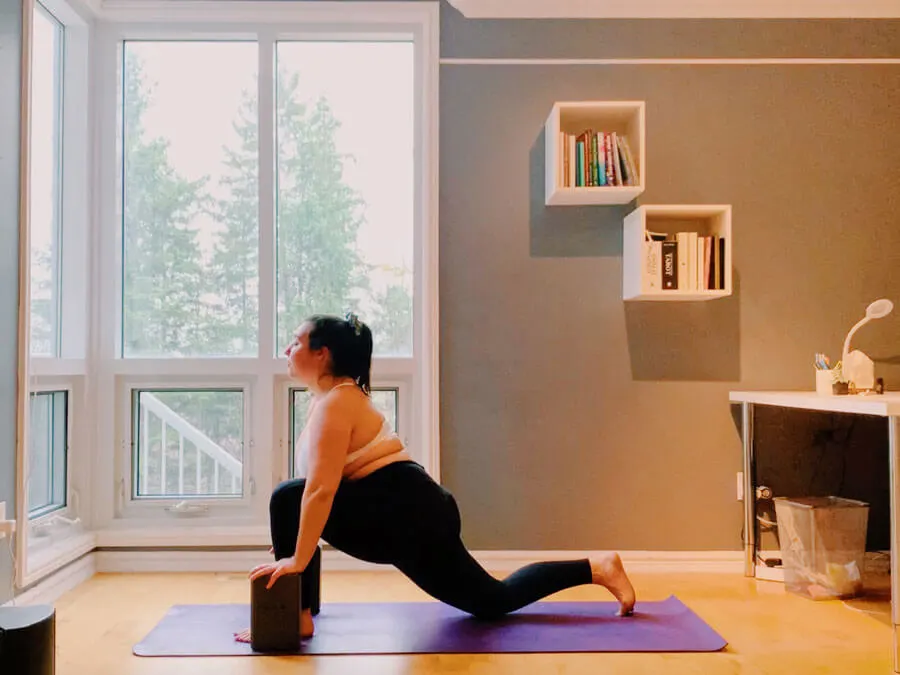
Low Lunge Pose (Anjaneyasana)
Low lunge is a great pose to keep you grounded while you begin working into your hips without too much effort.
From downward dog or from all fours, place your right foot between your hands. Walk your foot towards the top of your mat if need be so that you can lunge forward on your left knee without your right knee going too far over your ankle and causing strain. Aim to keep your right knee above your right ankle or just a bit further over, whatever is most comfortable for you. Allow your left-back knee to come to the ground. Toes can be tucked or untucked.
Depending on your flexibility, place your palms, fingertips, or use blocks placed under your hands and shine your chest to the front of your mat. Look straight ahead and keep your hips square by pulling your right hip back and your left hip forward. Breathe deeply for a minimum of 3 breaths. Repeat on the opposite foot.
Variations: If you have sensitive knees, place a towel under your knee or fold your mat for extra cushioning.
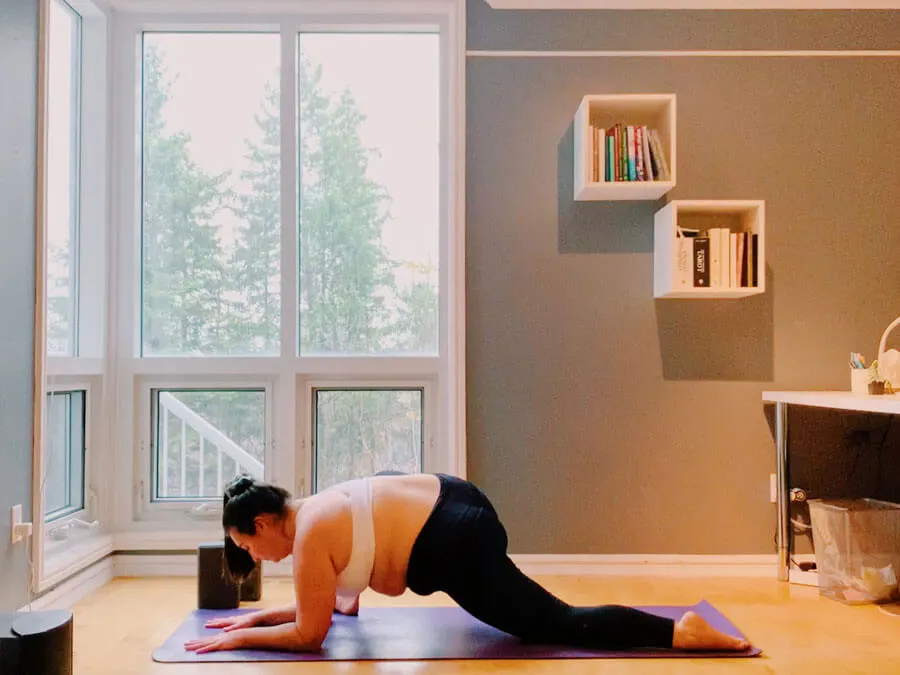
Lizard Pose (Utthan Pristhasana)
Lizard pose is a deep hip opener that many like to avoid because it can be intense, but if you’re patient, this pose will allow you to let go and certainly brings you into the present moment.
From a low lunge with your right foot forward and left knee on the mat, place both your hands to the left of your right foot. Walk your right foot out so that it’s closer to the edge of your mat, keeping it pointing straight to the top of your mat or angled to the right, perhaps your toes come off of the mat.
If you feel a deep stretch in your left hip flexor, stay here, with your hands planted on the floor. If it feels too intense, place blocks under your hands to bring the ground to you.
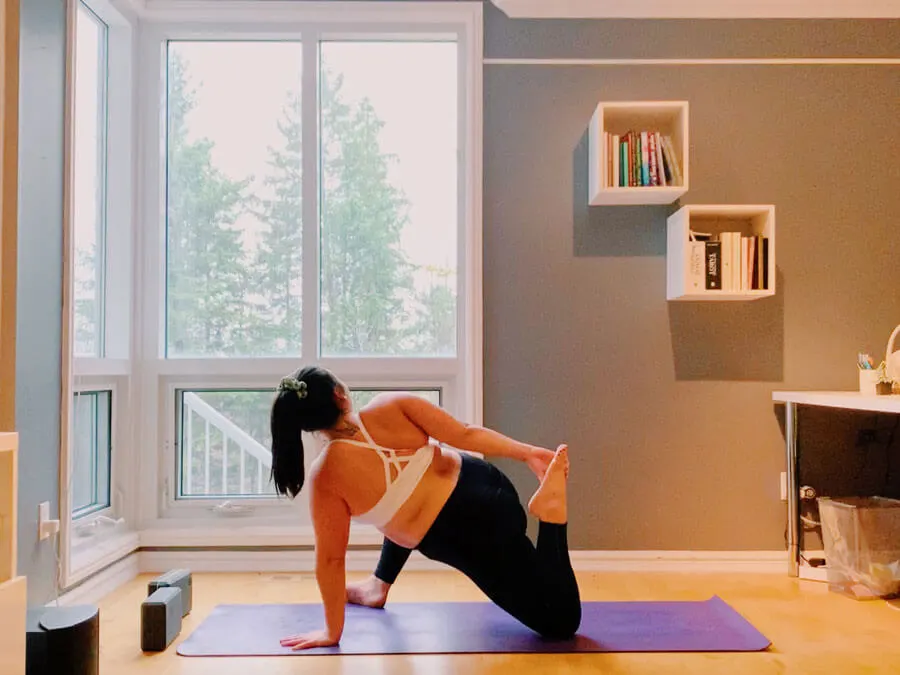
Variations: If you want it to be more intense, use blocks to place your forearms on or place your forearms directly on your mat.
If you want even more intensity, come back up onto your hands and reach your right hand up and back, keeping your left hand planted firmly. Kick your left foot towards your right hand and hold onto your foot with your right hand. You may need to rock your hips back in order to grab your foot if you have shorts arms or are not quite flexible enough to kick so far. Grabbing your foot just adds some assistance. If it feels good, roll onto the outside edge of your right foot, this may just happen naturally for you.
From here open your chest towards the right-hand side of the room, gently rolling your right shoulder back. Option to kick into your hand or to use your hand to gently pull your left foot towards your bum. Do what feels good!
No matter what variation you’re in, breathe deeply and into the area that you feel the most tension or stretch. Do your best to breathe into each variation before moving deeper. And if you try a variation that feels too deep just back off and come to stillness. Repeat on the opposite side.
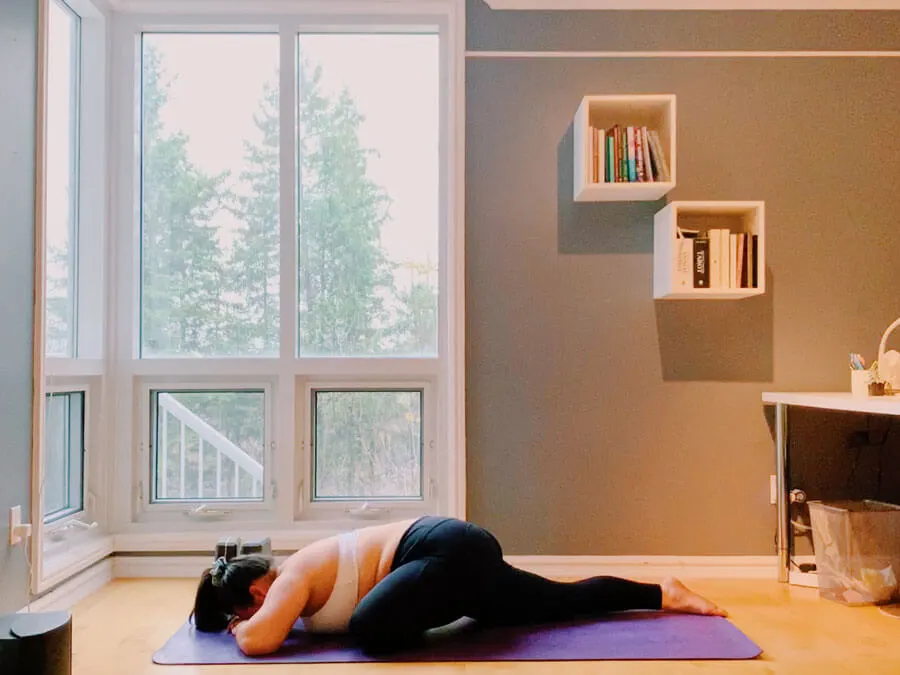
Sleeping Pigeon Pose (Eka Pada Rajakapotasana)
Pigeon is one of the most popular hip openers and many people tend to prefer over lizard as it’s a bit comfier but still provides a deep hip stretch.
From downward dog, bring your right knee towards your right wrist and place your leg on the ground, your right shin coming as parallel as it can to the top of your mat. Don’t worry if it’s not parallel, this isn’t accessible for a lot of people! Gently square your hips by pulling your right hip back and your left hip forward. If there is a lot of space between the mat and your right glute use a prop such as a block to help support you.
It may feel good to walk your left foot back for a deeper stretch of your left hip flexor. Take a deep breath in and elongate your spine. On your exhale slowly bow forward, keeping a straight spine. Firstly come down to your elbows and forearms. If that’s too intense, stay on your hands. Take a deep breath here and notice how it feels. If it’s good and you need a deeper stretch allow your hands to stack on top of each other and place your head on your hands like a pillow. Stay here or extend your hands forward and bring your forehead to the mat, always keeping your spine straight.
Move your shoulder blades down your back to release any tension in your upper back.
Take a minimum of 5 deep breaths (though I recommend 10) and breathe into where you feel the stretch the most, perhaps your hip flexors, glutes or even your lower back. Repeat on the opposite side, moving slowly as you transition.
Variations: At any point, you can use a block to prop up your hands, elbows or head. Use whatever you need to get comfy. A bolster can even be used under your body for a more restorative version.
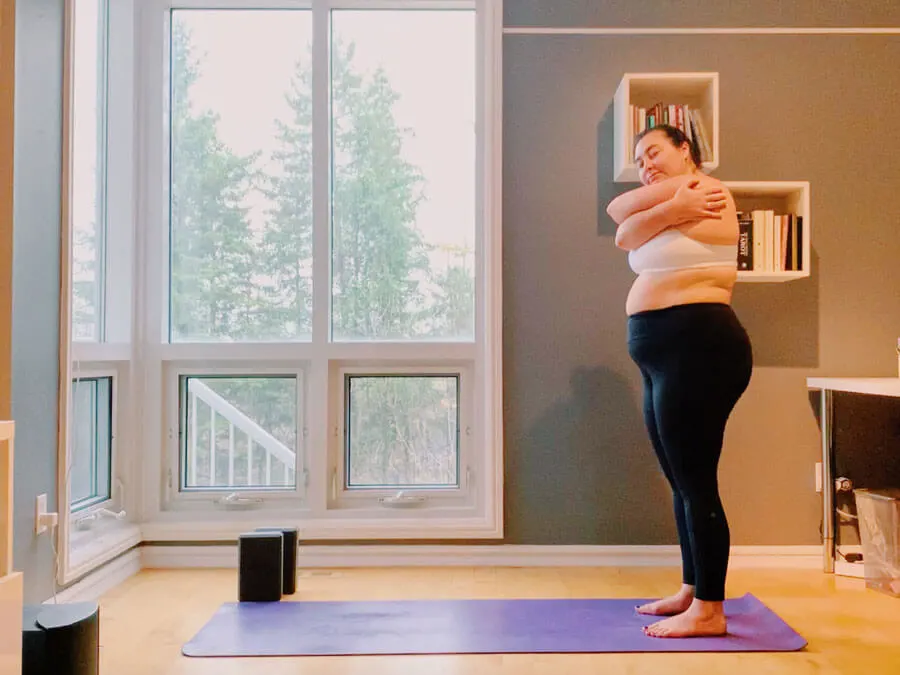
Hug
Not a yoga pose, but a gesture that you can do anytime for yourself and add into your yoga practice whenever you want! You don’t have to wait for someone to hug you and to receive support. As nice as that is, it’s beneficial to you and others when you firstly rely on yourself to give you the support you need when you’re feeling strong emotions.
Hugging yourself gives you the touch that humans often crave when they’re sad or going through a tough time. My suggestion is to hug yourself when you’re in tadasana (mountain pose), which is when you’re standing up with your feet grounded. Wrap your arms around yourself and maybe sway from side to side and appreciate yourself, no matter what emotional state you’re in.
Yoga For When You’re Feeling Sad Sequence
Be guided through this yoga practice that incorporates all of the yoga poses above and more for a gentle sequence that will leave you feeling more grounded and relaxed. Props you may want are two blocks. Get ready to let go and let out any tears if they come up, they need out! Enjoy your practice yogi!
Loved this practice? Subscribe on YouTube for new videos every Thursday!
FAQ
Can yoga make you cry?
Absolutely! There is nothing wrong with crying or not crying when practicing yoga. Emotions get trapped in our bodies in the form of energy and yoga helps to move that energy and thus emotions. As those emotions move and are released it’s not rare to feel that release in a physical manifestation such as crying.
Hip openers are, especially deep ones such as pigeon and lizard, the most common yoga poses that can spark crying as it’s our hips where we hold a lot of emotions, which is one of the reasons why it’s not uncommon for people to have tight hips!
Can yoga bring up emotions?
You bet it can! Like I mentioned above, emotions are often stored as energy in our bodies and as you move your moving energy (emotions) through your body you can feel emotions come to the surface. Pair that with that fact that coming to the present moment, which yoga teaches you to do, you really come into your body and are able to notice what feelings you are holding onto.
Is yoga good for your mental health?
It most certainly is! There’s a reason why there’s the phrase, movement is medicine, as movement is one natural way to care for your physical body as well as your mental health. This doesn’t mean that it completely replaces any medication you may use, but yoga is a great support tool for your mental health because it brings you into the present moment and mental health concerns such as anxiety are often caused by living in the future and worrying about it. When you come to the present moment, those worries disappear, even if just for a short period. This practice trains your mind to help you continue to do so even when you’re off the mat.

